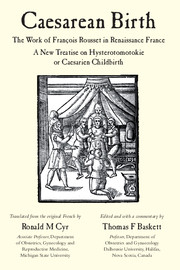 Caesarean Birth
Caesarean Birth Book contents
- Frontmatter
- Contents
- Acknowledgements
- Preface
- Translator's introduction
- François Rousset and the first text on caesarean section: a commentary by Thomas F Baskett
- A New Treatise on Hysterotomotokie or Caesarien Childbirth
- Sonnet
- Dedication
- Preface to the reader
- Part 1 Definition of caesarean childbirth
- Part 2 Second proof: logic (reason)
- Part 3 Third justification: expert opinion
- Part 4 Examples documenting other worse dangers from similar operations that are not caesarean
- Part 5 Other more popular justifications
- Part 6 On the fertility that remains after caesarean section
- A short guide to surgeons on the technique of caesarean
- Approbation
- Copyright
- Appendix 1 Summary of 16th century French history
- Appendix 2 Renée de France (1510–1575), Duchess of Ferrara, Chartres, Montargis and Nemours
- Appendix 3 Jacques de Savoie-Nemours (1531–1585), Duc de Nemours and Genevois
- Index
Part 4 - Examples documenting other worse dangers from similar operations that are not caesarean
Published online by Cambridge University Press: 05 June 2014
- Frontmatter
- Contents
- Acknowledgements
- Preface
- Translator's introduction
- François Rousset and the first text on caesarean section: a commentary by Thomas F Baskett
- A New Treatise on Hysterotomotokie or Caesarien Childbirth
- Sonnet
- Dedication
- Preface to the reader
- Part 1 Definition of caesarean childbirth
- Part 2 Second proof: logic (reason)
- Part 3 Third justification: expert opinion
- Part 4 Examples documenting other worse dangers from similar operations that are not caesarean
- Part 5 Other more popular justifications
- Part 6 On the fertility that remains after caesarean section
- A short guide to surgeons on the technique of caesarean
- Approbation
- Copyright
- Appendix 1 Summary of 16th century French history
- Appendix 2 Renée de France (1510–1575), Duchess of Ferrara, Chartres, Montargis and Nemours
- Appendix 3 Jacques de Savoie-Nemours (1531–1585), Duc de Nemours and Genevois
- Index
Summary
Leaving for now discussion of the bladder (but not the uterus), we will consider a few other operations performed through this incision which are more dangerous than the caesarean, yet not of themselves fatal. These will be addressed in five consecutive paragraphs.
The first deals with pregnant women unaware of their pregnancy, in whom a dead and necrotic fetus caused the uterus to rot inside, who died after some time for want of an operation, yet might have lived had the problem been diagnosed and surgery performed in a timely manner.
The second, of women – some pregnant, some not – suffering from a uterine abscess and drained, not by caesarean but by the actual cautery through the abdomen, without dying, or losing the pregnancy, which is an operation worse than a caesarean.
The third of diseases where the uterus is so necrotic inside, near its fundus, that the dead fetus is expelled from its cavity into the abdomen, whence it is later removed through the abdominal wall, where it was believed to be a large abscess, without the woman dying or being unable to bear children in the future, the uterus having healed itself.
The fourth case, of women whose prolapsed and necrotic uterus was totally removed without causing death – this being accomplished by cutting, cautery or ligature.
The fifth, of women whose prolapsed uterus underwent necrosis and fell out spontaneously without death, or subsequent illness.
Information
- Type
- Chapter
- Information
- Caesarean BirthThe Work of François Rousset in Renaissance France - A New Treatise on Hysterotomotokie or Caesarian Childbirth, pp. 67 - 84Publisher: Cambridge University PressPrint publication year: 2010